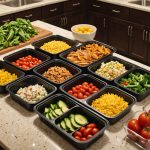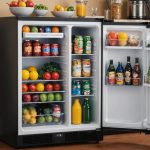Understanding Bread Knife Basics
Choosing the right knife for bread is essential for both efficiency and ease of use in the kitchen. There are various bread knife essentials that one must consider. Understanding the different knife types is crucial as it influences how effectively you can slice different breads. A bread knife, typically, has a serrated edge, which distinguishes it from other knife types. The serration is designed to cut through bread with ease without crushing it.
Various slicing techniques can be employed to get the perfect slice, and each technique relies on the unique features of the knife in use. When considering bread knives, prioritize key features that affect slicing efficiency, such as the knife’s serration, weight, and balance. A bread knife should feel comfortable in your hand while providing a controlled cut. This ensures the bread’s crust remains intact without tearing the soft inside.
Also to see : Top Rugged Kitchen Table Surfaces for Active Families: Your Essential Guide to Long-Lasting Options
Selecting an appropriate knife type can revolutionize your bread slicing experience, making it seamless and efficient. Remember, a quality bread knife will not only perform well but also offer long-lasting service. Identifying your specific slicing needs will guide you in making an informed decision.
Blade Material Considerations
When selecting a bread knife, the choice of blade materials is crucial. The two primary options are stainless steel and carbon steel, both offering distinct benefits. Stainless steel is known for its resistance to rust and stains, making it a low-maintenance option that remains sharp with minimal upkeep. Its durability is favoured for everyday use, providing consistent performance over time. Conversely, carbon steel is prized for its exceptional sharpness and ability to maintain a fine edge with proper care. However, it requires more diligent maintenance to prevent rust and discoloration.
Also to discover : Master the Perfect Bake: Top-Rated Oven Thermometers for Precision Cooking Every Time!
The durability and sharpness of a blade are directly influenced by its material composition. Stainless steel blades, while strong, may dull quicker than carbon steel, which can maintain a keen edge longer. For those seeking a combination of sharpness and ease of maintenance, high-carbon stainless steel is a recommended choice, blending the two materials’ best attributes.
When purchasing a bread knife, seek out brands renowned for high-quality blade materials. Ensuring your knife’s blade matches your usage requirements will provide a reliable and efficient cutting experience.
Types of Serration
Understanding serration types is pivotal in selecting a bread knife tailored to your needs. Bread knife serration can be classified mainly into two styles: wedge and scalloped. The wedge style, resembling tiny triangles, excels at slicing through hard, crusty breads. Its pointed tips pierce the crust effectively, though it may be a bit harsh on softer interiors.
Conversely, scalloped serration features rounded edges that glides smoothly. This style minimizes tearing, making it ideal for softer types of bread, like sandwich loaves and banana bread. While each has its advantages, the choice between them often depends on the bread’s texture and your personal slicing preferences.
Selecting between these serration styles involves weighing the pros and cons. Wedge serrations, for example, may require more maintenance due to their sharper points. On the other hand, scalloped serrations are gentle yet may not grip crusts as effectively. Understanding these nuances ensures you enjoy a satisfying bread-cutting experience. Consider the kind of breads you typically slice to guide your decision in choosing the suitable serration style for your daily kitchen exploits.
Handle Ergonomics and Comfort
Selecting a bread knife with well-designed handle ergonomics is crucial for a comfortable and satisfying slicing experience. A comfortable grip can significantly reduce hand fatigue and ensure precise slicing. Different handle designs cater to various needs, with shapes ranging from curved to straight forms.
It’s essential to consider materials when evaluating handle design. Plastic and rubber handles often provide a comfort grip, reducing slipping and improving control. Conversely, wooden handles offer a classic aesthetic but may require regular maintenance to prolong their lifespan due to potential moisture absorption.
For optimal user satisfaction, the handle must feel natural in the hand. Testing a knife prior to purchase is advisable. Hold it in your typical slicing position to evaluate the fit and weight balance. If a knife feels cumbersome, it may hinder your ability to make clean cuts.
To ensure a sound investment, pay attention to these handle features:
- Shape: Matches the natural curve of your hand.
- Material: Offers durability and grip security.
- Weight: Contributes to a balanced feel throughout usage.
Ultimately, the right handle design enhances your culinary tasks, ensuring both comfort and practicality.
Size and Length Options
Choosing the right bread knife size and length can significantly impact slicing performance and user comfort. Bread knives typically range from 7 to 12 inches in length, each serving different purposes. A longer knife, usually 10 to 12 inches, is ideal for slicing larger loaves like sourdough and rustic breads. These provide ample blade length, allowing smooth, continuous slicing motions with less frequent repositioning.
Conversely, shorter bread knives, around 7 to 9 inches, are more suited for delicate tasks and smaller breads such as baguettes and rolls. They allow greater precision and control, making them perfect for intricate or smaller cuts.
When selecting a knife length, consider the types of bread you commonly slice. Larger knives excel in handling big loaf dimensions, delivering cleaner slices with minimal effort. Personal preference also plays a crucial role; some users might prefer a shorter knife’s agility for maneuverability.
In conclusion, balancing bread types with personal slicing techniques will guide your decision. Test various lengths to experience firsthand how each one influences your cutting strategy, ultimately enhancing your bread-cutting experience and making it more enjoyable.
Maintenance and Care
Proper knife maintenance is crucial to ensure longevity and performance. Regular sharpening not only revives a blade’s edge but also maintains its cutting precision. Using a manual or electric sharpener tailored for serrated knives helps preserve the unique grooved edges, preventing damage. There are also professional services available for sharpening that can extend the life of your knife even further.
In addition to sharpening, knowing how to safely clean your bread knife is vital. Most knives should be cleaned by hand using a gentle detergent and warm water. A soft cloth or sponge is recommended to avoid abrasive damage. Essential to cleaning is immediate drying to prevent moisture corrosion, especially with carbon steel blades prone to rust.
Proper storage also contributes to maintaining your knife’s conditions. Using a knife block, magnetic strip, or blade guard helps protect the blade and prevent accidental dulling or damage. This care ensures your knife remains ready for efficient slicing.
Finally, to extend the lifespan of your bread knife, avoid cutting on hard surfaces like stone or glass. Wooden or plastic cutting boards are ideal. Additionally, refrain from using the knife on non-bread items that could potentially compromise its structure and performance.
Brand Comparisons and Recommendations
Choosing from the best bread knife brands can enhance your kitchen experience. Top contenders are known for their quality and durability, ensuring each slice is effortless and precise. When exploring product comparisons, consider brands like Wüsthof and Victorinox, which consistently receive high praises for their precision and comfort. Each offers unique features, such as ergonomic handles and diverse serration styles.
Analyzing user reviews provides insight into performance under real-world conditions. Users often highlight aspects such as the knife’s balance, cutting efficiency, and ease of maintenance. It becomes evident which brands excel and why users rely on them for daily bread slicing.
In terms of recommendations, the right choice often depends on price points and desired features. For those prioritising affordability without compromising performance, brands like Mercer Culinary offer excellent value. Conversely, for premium quality and craftsmanship, consider Splurge on brands like Zwilling J.A. Henckels, known for their lasting edges and elegant design.
Ultimately, investing in a reputable brand ensures reliable performance, enhancing your bread-cutting routine. When selecting, balance factors like budget, features, and personal needs to make an informed decision.
Practical Use Cases
Incorporating specific bread cutting techniques can greatly improve the slicing experience across various types of bread. Techniques vary based on the bread’s texture. For instance, slicing a crusty sourdough requires a gentle sawing motion, utilizing the knife’s serration to penetrate the crust gradually while preserving the crumb. Alternatively, softer breads like brioche benefit from light, even strokes to avoid compression.
Case studies highlight the importance of choosing the right knife based on your baking habits. Bakers who frequently bake large rustic loaves benefit from longer knives, which enable smooth slicing motions across wide crusts. Conversely, shorter blades are ideal for those who predominantly work with smaller or artisanal loaves that require precision and agility.
Selecting a knife tailored to specific uses enhances both functionality and satisfaction in the kitchen. Consider scenarios such as slicing delicate pastries or hearty baguettes; each demands a different approach for optimal results. Identifying your primary bread types and cutting patterns will lead to a better-informed choice, ultimately transforming your bread preparation routine into a more efficient and enjoyable process.
Visual Aids and Resources
In today’s visually driven world, the use of visual aids can significantly enhance understanding, especially when it comes to mastering slicing techniques. Instructional videos offer step-by-step guidance, presenting techniques in a way that static text can’t, helping users visualise the ideal motion and grip. These resources are particularly helpful for both beginners looking to improve their skills and seasoned chefs refining their technique.
Visual guides often accompany videos, providing a quick reference for essential steps without needing to replay footage. Such guides can exemplify the correct knife angle and ideal pressure needed for various bread types, making the slicing process more intuitive.
For comprehensive learning, explore platforms featuring a plethora of instructional videos on bread slicing. They cover everything from basic loaves to elaborate artisanal creations. Additionally, these resources may include tips for knife maintenance, ensuring your tool remains in optimal condition.
Educational content can often be found on culinary websites, dedicated YouTube channels, and cooking apps explicitly focused on bread preparation. These platforms provide a treasure trove of visuals and insights into achieving the perfect slice, supporting individuals in transforming their bread-cutting skills into a truly satisfying kitchen activity.











